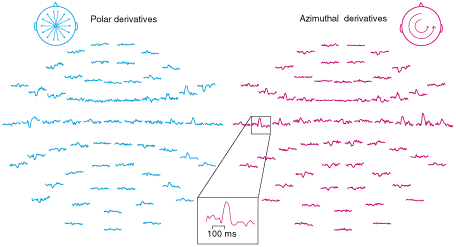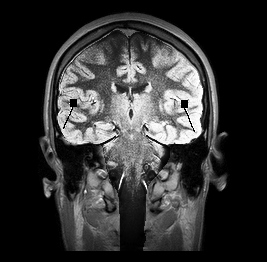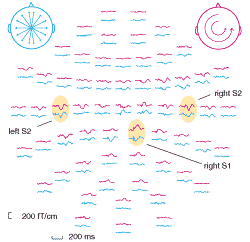SELECTED RESEARCH INTERESTS
122-SQUID neuromagnetometer
In the middle of 1992, a sophisticated 122-channel brain research system
became operational. This instrument is the culmination of more than ten years
of development of the magnetoencephalographic (MEG) technology in the LTL. The
magnetic field caused by neural currents flowing in the brain is measured by
an array of 122 superconducting sensors which cover the subject's head in a
helmetlike fashion.
The MEG technique is based on the Superconducting QUantum Interference Device,
the SQUID, an ultrasensitive detector of magnetic flux, introduced in the late
1960's by James Zimmerman. The SQUID is a superconducting ring interrupted by
one or two Josephson junctions; for operation, it must be kept at 4.2 K in
liquid helium. At present, about 60 laboratories worldwide are engaged in
magnetoencephalographic studies of the human brain.
MEG is a challenging technology. First, only the most sophisticated sensors of
magnetic flux, the SQUIDs, can be used. Second, stray fields generated by
electric power lines, lights, electrical motors, lifts, trains, computers,
etc. easily mask the tiny biomagnetic signals. In a modern hospital or
research laboratory the disturbances may be several million times larger than
the signals of interest. To avoid the stray fields, MEG measurements are
normally carried out in shielded rooms which have surfaces completely clad
with several layers of mu-metal plates or similar high-permeability material.
From the measured field distribution it is possible to calculate the brain
area, usually approximated by a current dipole, which has been activated by a
sensory stimulus, such as a sound, a picture, or a touch. MEG is closely
related to electroencephalography (EEG), the measurement of electric
potentials on the scalp, but provides better spatial resolution, a few
millimeters under favorable conditions. MEG is a completely noninvasive
technique, with a 1-ms time resolution. The method is thus ideal for studies
of signal processing in the human brain.
The new MEG system in Helsinki has been designed and manufactured by an
R&D company, Neuromag Ltd, working in the LTL. The ultrasensitive dc
SQUIDs used in this prototype magnetometer were made by the IBM Thomas J.
Watson Research Center in 1983 as a by-product of a large project to develop
a superconducting computer. IBM has loaned the SQUIDs to the
Helsinki University of Technology as part of
an ongoing joint research program.
Neuromagnetic fields are typically 50 - 500 fT in strength, i.e., one part
in 109 or 108 of the earth's geomagnetic field. When a
group of neighboring neurons in the brain act in concert, the magnetic signal
generated by them can be measured outside the subject's head. From the field
distribution it is then possible to identify the active brain region. For
example, after stimulation of various parts of the skin, it is possible to
calculate the areas representing these body parts in the cerebral cortex. A
highly individual functional brain map is thus obtained totally noninvasively.
The auditory and visual areas as well as sources of abnormal activity can be
studied in the same way.
To further decrease the interference level, the pick-up coils of the new
122-channel MEG-system in Helsinki are figure-of-eight double-loops to make
them "nearsighted". The coils see nearby sources in the brain clearly because
the gradients are large, but the loops are insensitive to the interfering
stray fields originating from sources farther away. Planar gradiometer sensors
of this type couple strongest to current sources located directly underneath
the pickup coil, when the source is at right angles to the double-loop
configuration. The thin-film pickup coils are deposited on 28 × 28
mm2 silicon chips, directly connected to the dc SQUIDs. The sensors
have an equivalent noise level of less than 5 fT/(cm÷Hz). The device employs
two orthogonal figure-of-eight gradiometers at each of the 61 measurement
sites.

Fig. 10. Auditory evoked responses to 1-kHz tones, presented once
every 4 s. The left side shows 61 polar (blue traces) and the right side 61
azimuthal derivatives (red traces) of Bz, the component of
the magnetic field perpendicular to the inner surface of the helmet-like
dewar. The head is "flattened" using the zenithal equidistant projection. The
directions of
 Bz/
Bz/ y and
y and
 Bz/
Bz/ x, respectively, are
illustrated on the schematic heads; the nose points up. The insert in the
middle depicts the enlarged response of one channel.
x, respectively, are
illustrated on the schematic heads; the nose points up. The insert in the
middle depicts the enlarged response of one channel.
Figure 10 illustrates data on the human auditory system measured with the new
instrument. Traces from each of the 122 SQUID detectors show how the magnetic
field varies with time. Maximum signals were recorded near the perimeter at
left and right above the auditory areas of the brain.

Fig. 11. Locations (squares) and orientations of sources for the
auditory responses of Fig. 10, superimposed on an MR (magnetic resonance)
image. Both sources agree with activity in the lower bank of the Sylvian
fissure, where the left and right primary auditory cortices A1 are located.
The source locations of the response are shown in Fig. 11 by the squares
on the MR image. This is how dynamic MEG data can be used to identify both
normal and abnormal functions of brain structures which are anatomically so
crisply seen in the static MRI scans. As a result, the combination of MEG and
MRI techniques has considerable clinical potential.

Fig. 12. Somatosensory evoked responses of a subject whose left ankle
was stimulated electrically every 3 s. The polar derivatives of the magnetic
field Bz, perpendicular to the head along the longitudes
(see schematic head in the upper left corner and the blue signals) and the
azimuthal derivatives along the latitudes (red signals) are plotted above each
other at every measurement site. The first cortical signal at the right primary
somatosensory cortex S1 appears 40 ms after the stimulus onset; the foot
projection area is close to the midline. The second somatosensory cortices S2
in both hemispheres are activated maximally at 140 ms. The yellow ovals
illustrate the maximum signals arising from the S1 cortex at the top of the
head and from the two S2 cortices, one in each hemisphere.
The whole-head system begins a new era in neuromagnetism. The simultaneous
activity of different areas of the cortex, for example in the two hemispheres,
can now be observed directly. This is again exemplified by Fig. 12 which
illustrates responses to electrical stimulation of the tibial nerve at the
left ankle. Three locations of maximum signals are immediately obvious.
The global pictures of the magnetic field distribution that now have been
obtained, for the first time, are of paramount importance for advanced
experiments on the working human brain, particularily for studies of cognitive
processes. Furthermore, all-inclusive mapping of spontaneous activity is now
feasible as well. This is extremely valuable for clinical applications.
It seems clear that the unprecedented spatiotemporal resolving power of
whole-head MEG opens vast experimental possibilities for noninvasive studies
in human neuroscience. Compared with EEG, MEG is a much faster technique:
instead of first pasting a set of electrodes on the scalp, requiring at least
half an hour, the subject's head is just put inside the helmet. Descriptions
of typical MEG studies are given in the next two sections.








